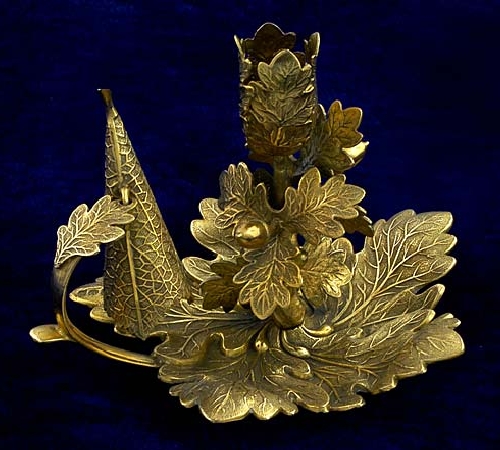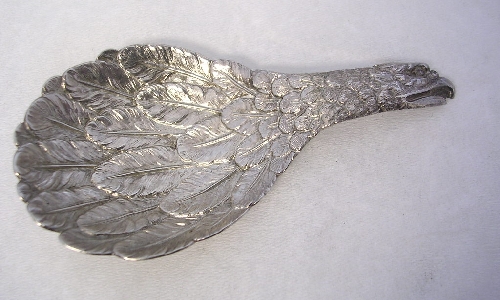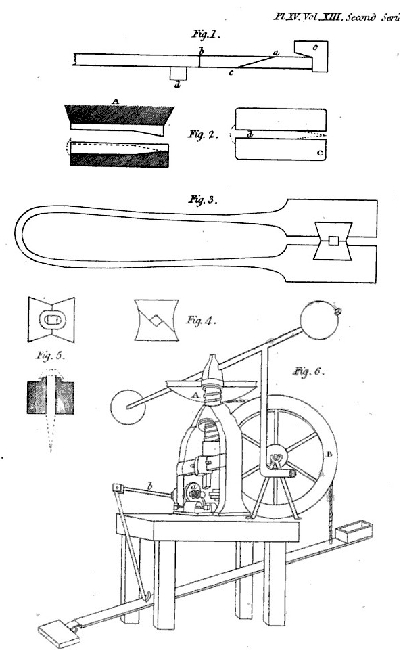Joseph Willmore (1773-1855)
Biography
 Silver-gilt taperstick, Joseph Willmore, 1831. This naturalistic
design based on leaves also contains a snuffer attached to the handle. 19th century naturalism is exemplified by this one. Birmingham Assay Office.
Silver-gilt taperstick, Joseph Willmore, 1831. This naturalistic
design based on leaves also contains a snuffer attached to the handle. 19th century naturalism is exemplified by this one. Birmingham Assay Office.
Joseph Willmore was a grandson of Thomas Willmore who was one of silversmiths active since the establishment of Birmigham Assay Office in 1773. Thomas Willmore entered his mark at Birmingham Assay Office in partnership with James Alston between 1773 and 1801, though later marks show that both were independent silversmiths. Willmore was a bucklemaker and Alston operated as a button maker.
Joseph Willmore took over the business on Thomas's death in 1816. Joseph had already registered his mark at Birmingham Assay Office in 1806-7 as a snuff-box maker.
He also registered at London Assay Office in 1814-5 where he had a showroom in Bouverie Street and later Thavies Inn in Holborn. This fact suggests that he has distinctive sence of business. He clearly understood the importance of marketing his products to his wealthy customers living in London. Usually a silversmith delegates the marketing operation to the retailer who has close relationship with the wealty customers. However he inteds to control the marketing of his products by himself.
He registered a new hallmark at Birmingham Assay Office as a make of handles of knife and fork in 1831-2, and as a make of silver-gilt knife, fork and spoon in 1832-3.
Joseph entered into a partnership with two other Birmingham silversmiths, John Yapp and John Woodward.
 Caddy spoon by Joseph Willmore, 1814. The Eagles wing; This rare and elegant design was created by Joseph Wilmore in Birmingham in 1814. A similar pattern was produced by Matthew Linwood in Birmingham a couple of years later. The Eagles wing consist of a bowl with overlapping feathers and a matching handle terminating in the head and beak. This design is rare and although copied by other silversmiths an early example will be quite coveted. This spoon style has been adopted by the Society of Cady spoon Collectors.His death in 1855 brought an end to the Willmore connection with silversmithing.
Caddy spoon by Joseph Willmore, 1814. The Eagles wing; This rare and elegant design was created by Joseph Wilmore in Birmingham in 1814. A similar pattern was produced by Matthew Linwood in Birmingham a couple of years later. The Eagles wing consist of a bowl with overlapping feathers and a matching handle terminating in the head and beak. This design is rare and although copied by other silversmiths an early example will be quite coveted. This spoon style has been adopted by the Society of Cady spoon Collectors.His death in 1855 brought an end to the Willmore connection with silversmithing.
Arthur G. Grimwade "London Goldsmiths 1697-1837 Their marks & Lives"
Birmingham Back to Backs
The Birmingham Back to Backs (also known as Court 15) at 50–54 Inge Street and 55–63 Hurst Street are the last surviving court of back-to-back houses in Birmingham, England, now operated as a museum by the National Trust.
They are examples of the thousands of similar houses that were built, literally back to back, around courtyards, for the rapidly increasing population of Britain's expanding industrial towns.
Numerous back-to-back houses, two or three storeys high, were built in Birmingham during the 19th century, the majority of them were still in quite good condition in the early 20th century and also prior to their demolition. Most of these houses were concentrated in inner-city areas such as Ladywood, Handsworth, Aston, Small Heath and Highgate. By the early 1970s, almost all of Birmingham's back-to-back houses had been demolished. The occupants were rehoused in new council houses and flats, some in redeveloped inner-city areas, while the majority moved to new housing estates such as Castle Vale and Chelmsley Wood.
Willmore's Court (Court 14 Inge Stree) in 1802
Court 14 was completed in 1802 by Joseph Willmore, a silversmith. It consisted of six front and eleven back houses with some workshops on the larger southern end of the building plot. When opened, it was known as Willmore's Court but was later renamed Court 14 Inge Street. It has since been demolished.
Patent for a new method and processes in the manufacturing of nails
Joseph Willmore and John Tonks, plater, were granted a patent for a new method and processes in the manufacturing of nails on 28th May 1808. Joseph Willmore was a silversmith but also an entrepreneur pursuing the drastic improvement of the productivity by using the newly invented technology in the Industrial Revolution.
On the page 366 of “The Repertory of patent inventions Volume XIII - Second Series“, published at London in 1808, describes that;
“Specification of the Patent granted to JOSEPH WILLMORE, of Birmingham, in the Country of Warwick, Silversmith, and JOHN TONKS, of the same Place, Plater; for a new Method and Processes in the manufacturing of Nails. Dated May 28, 1808.”
 Joseph Willmore's patent for a new method and processes in the manufacturing of nails in 1808.“With a Plate.
Joseph Willmore's patent for a new method and processes in the manufacturing of nails in 1808.“With a Plate.
To all to whom these presents shall come, &c. NOW KNOW YE, that in compliance with said proviso, we the said Joseph Willmore and John Tonks do hereby declare that the nature of our said invention, and the manner in which the same is to be performed, are as herein hereafter set forth; that is to say: We take a nail-rod, of a size suitable to the size of the nail intended to be manufactured, and applying it to a common screw-press, mounted with proper cutter, cut off from the end of the rod two pieces at once, obliquely across the rod in one place, and directly across it in another, as is shown in Fig.1, (Plate XV.) at a
e and b. Two studs or stops are set up, one at c and the other at d, which are attached to the press, and are adjustable by screws or other means, the stud c being adjustable or moveable in the direction of the rod, for the purpose of ascertaining the length of the nail, and both c and d being adjustable in the cross direction of the rod, so that the rod being pressed gently always against c, and sideways against c and d, the obliquity of the cut, according to the kind of nail to be made, is thereby determined, as well as the length of the nail; and the length of the two pieces may either nearly equal or unequal, by means of the said adjustments, as will be evident on due consideration. This may be called the first operation.
The second operation is to anneal the pieces so cut off, if the iron should not be sufficiently malleable, which we do in the usual and well-known manner.
The third operation is that of heading, which for clasp-head nails consists of two parts, one for gathering and the other for forming the head of the nail. The first part of this operation is performed by putting a piece cut off the rod of iron, as before described, into a pair of clams, leaving as much of the thick end projecting above the clams as is sufficient to form the head. These clams have steel bits let into them with sharp edges, which press only against the two opposite sides of the piece, and which have the effect of two chissels when the punch of the press is brought down upon the piece with considerable force, and raise or gather up iron on each side towards forming the head. The second part of this operation is to put the piece thus prepared into another pair of clams, having bits formed to correspond to the underside of the head; and the punch, having the impression of the upper side of the head engraved or sunk into it, is brought to press strongly upon the head in the clams, and thereby the clasp-head is properly formed. For nails intended to have rose heads, or any other kind of heads, except clasp heads, the first part of this operation is not absolutely necessary, though we think it advisable to be done, but the bits which for clasp nails must have sharp edges, must for other kind of nails have blunt edges, to prevent the under cutting. For the second part of this operation the piece is put either into a pair of clams or into the tool commonly called a bore, and then pressed with punches, properly engraved or sunk, according to the kind of head wanted. By the first operation the piece cut off the rod of iron is formed something like a mortise-chissel, the present or fourth operation is to point it, which is done by putting the piece into a bed of steel, in which is cut a nick or groove d, having parallel sides, see the plan C, Fig.2, but the bottom rising towards the end where the point of the nail is to be formed, see the section B of the bed. The punch is shown at A, and the end which presses upon the point of the nail is made to project farther than the other part, so as to meet the corresponding part of the bed when the punch is brought upon the nail. The groove or nick in the bed should be just wide enough to receive the piece easily, but prevent it from twisting when the impression is made. The piece is put twice into the nick; once with the chissel end lying horizontal, and next turned a quarter round to press the chissel edge into a pointed form. If the nails by the strong pressure which is necessary in this operation should become too hard to clench, we in such anneal them in the ordinary way, which may be called the fifth operation.
The third, forth, and fifth operations above described we apply to nails, or pieces cut off from sheet or rolled iron in the ordinary way; but as they , in consequence of the fifth operation, which is necessary to give them the quality of clenching, are apt to be too soft to drive well, we apply a sixth operation, viz. quenching them when red hot in water, or other proper fluid, which gives them stiffness enough to drive without destroying the quality of clenching.
Fig.3 shows a pair of clams, with bits or dies let into them, which can be renewed from time to time with more case, and at less expense, than by the usual method. These bits are proper for the first part of the third operation.
Fig.4 a pair of bits or dies proper for making either rose heads or flat heads.
Fig.5 a pair of bits or dies proper for the second part of the third operation for clasp head nails: the dotted lines show the head of the nail.
Fig.6 is a view of the common screw-press; in which is shown the side pin or screw a, by which the clams are firmly pressed together at the time the punch is pressed down upon the nail. This pin or screw is generally worked by the foot by means of the lever b, connected with a treadle, while the hand applied its force to the handle of the fly; but we fix to the head of the main screw a portion of a pully A (or a whole one), to which is attached a rope, chain, belt, or other connecting pliable material, which flying round the edge of another pully B fixed to the frame of the press, and standing vertically descends, and is attached to the moveable end the treadle; and on this treadle we place a weight, heavy enough to press the clams together with sufficient force.
By means of the latter-described machinery, which we only claim as our invention, the operation of pressing is performed by the action of the hand only, and is found very convenient.
In witness whereof, &c."
 Top
Top Site Map
Site Map References
References About Me
About Me